
Do you like to have a cup of hot chocolate or oatmeal in the morning? If so, you may have wondered if it’s possible to microwave milk for these recipes.
So, Can you microwave milk?
You can heat milk in the microwave – some people prefer to do this, and others would recommend against it. Heating milk in the microwave isn’t as risky as long as at most 20 seconds are used at a time. Doing this will help to prevent the milk from boiling and overflowing.
One of the main challenges people have with microwaving milk is the fear of it boiling over. This can be prevented by taking a few simple steps. However, there are some things you need to know before microwaving milk.
In this article, we will discuss the pros and cons of microwaving milk, as well as the consequences of microwaving milk. We will also provide tips on how to microwave milk safely. Finally, we will give you hot chocolate and oatmeal recipes that include microwaved milk.
Microwaving Milk: Is It Safe?
“Our investigation shows that heat treatment of milk in household microwave ovens does not damage vitamins A, E, B1, B2, and B6,” according to a study published in the Journal of Dairy Research on Effect of Microwave Heating on Vitamins A, E, B15 B2, and B6 in milk.
Another study was conducted and published in the US National Library of Medicine on the mineral balance in milk heated using microwave energy. The researchers concluded that “Microwave heating was no more harmful to the milk than traditional heating.”
Microwave heating does not change the mineral composition of milk.
Pasteurization of milk requires heating it until it reaches a specific temperature. It is then chilled to store for an extended period of time.
It is not recommended to attempt pasteurizing milk at home because the procedure typically includes other steps, and doing it yourself may cause those who drink it to feel ill. As a result, purchasing already pasteurized milk is advised.
LEARN MORE: Can You Microwave Milk for Hot Chocolate?
Risks of Heating Milk in the Microwave
The debate over whether microwaving milk is safe for people has been going on for years. However, many think it’s worth doing, provided that you take a few precautions.
The main reason microwaving milk is not recommended is that it can create dangerous hot spots in the milk. These hot spots can cause the milk to boil and form a scalding hot liquid.
Microwaving milk can also change the structure of the milk proteins, making them less digestive.
Milk heated in a microwave has a considerable risk of burning at the bottom of the container. When milk is burned, it becomes unpleasant to drink and has a burnt or toasted flavor.
Heat is not evenly distributed when you heat milk in the microwave. As a result, hot spots form, which can burn someone’s mouth, including children.
Furthermore, when breast milk is microwaved, its immunological components are destroyed by overheating, decreasing antioxidant and nutritional properties.
It is also possible to blend the heated milk’s skin layer back into the liquid, but the taste and texture of the milk may change.
LEARN MORE: Can You Use Parchment Paper In The Microwave?
How to Heat Milk in the Microwave
If you think of heating your milk in the microwave, you should be aware of the risks involved. Microwaving milk can cause it to explode, especially if it is heated too much or not stirred enough.
That said, there are some benefits to microwaving milk. For one, it is a convenient way to heat your milk without using a stovetop. Microwaving milk also retains more nutrients than heating it on the stove.
So, when you choose to microwave your milk, there are a few things you can do to minimize the risk of an explosion. Here are some steps that you can follow:
- In a microwave-safe container, add the milk. It’s better to leave at least an inch of clearance at the top.
- Set the microwave to medium-high and time it for 15 seconds. Microwaves heat more evenly when they’re turned on a little earlier.
- Remove the container and gently stir the milk.
- Microwave for another 15 seconds on medium-high before removing and stirring.
- Give it a stir every 15 seconds. Continue this process, stopping at 15-second intervals to stir.
- When your milk has steam coming out of it, it’s ready to drink.
LEARN MORE: Can You Microwave Cardboard Cups?
The Time Needed for Microwaving Milk
Microwaving milk is a fast and convenient way to heat it, but some risks are associated with microwaving milk. It’s important to know how long milk needs to be microwaved to avoid these risks.
The general rule of thumb is to heat the milk slowly, regardless of which tool you’re using. If you try to rush the process, you’ll end up boiling milk all over your microwave.
Milk that is at room temperature performs better in recipes than cold milk. So use the microwave to remove the chill from fresh refrigerated milk. Then you have to microwave 250 mL (1 cup) milk on high for 40 to 45 seconds (100 percent ).
The times are calculated using a 700-watt microwave oven. Cooking times should be adjusted to fit your range.
Microwaving milk for too long or at too high a power setting also risks overheating and scorching the milk. Pay close attention to microwaving times and temperatures to avoid these problems.
LEARN MORE: Can You Use Aluminum Foil in Microwave?
What Can You Make With Your Microwaved Milk?
What can you make with your microwaved milk? You can make hot chocolate, oatmeal, coffee, tea, and more! Hot chocolate and oatmeals are people’s most popular recipes with microwaved milk. Just be sure to follow the recipe closely, as microwaving milk can change its consistency.
Microwaved Milk in Hot Chocolate
Heating milk for hot chocolate in the microwave may result in a smooth and creamy hot chocolate heated evenly. Microwaving milk also prevents the milk from scorching on the bottom of the pot, which can happen when heating milk on the stovetop.
Microwaving milk for hot chocolate is a quick and easy way to make this delicious beverage. To microwave milk for hot chocolate, place a microwave-safe container with the desired amount of milk in it in the microwave. Then you may microwave on high for about 30 seconds or until the milk is hot.
Microwaved Milk and Oatmeal
Oatmeal is a healthy breakfast choice, and microwaving milk for oatmeal is a quick and easy way to make this dish.
You can even microwave your oatmeal with milk. In a microwave-safe bowl, combine the oatmeal and milk, leaving room for expansion. The oats may also puff up in the microwave. It may flow over the edges when the bowl isn’t large enough.
Mix in the milk and oatmeal thoroughly. You may want to add a little more milk than you would if you were preparing it on the stove, or you may add some extra milk at the end if necessary. Cook the oats for 1-2 minutes over medium-high heat, then remove and stir.
LEARN MORE: Can You Use Parchment Paper In The Microwave?
Conclusion
So, now you know, microwaved milk is not as harmful as some people think. But there are still risks associated with it. Microwaving milk for different recipes is an easy way to enjoy the foods without using the stove. Just be sure to follow the safety guidelines listed above so that you can avoid any potential dangers.
Thanks for reading! I hope this article has helped you understand the pros and cons of microwaving milk. Be sure to share it with your friends and family if you find it helpful.



